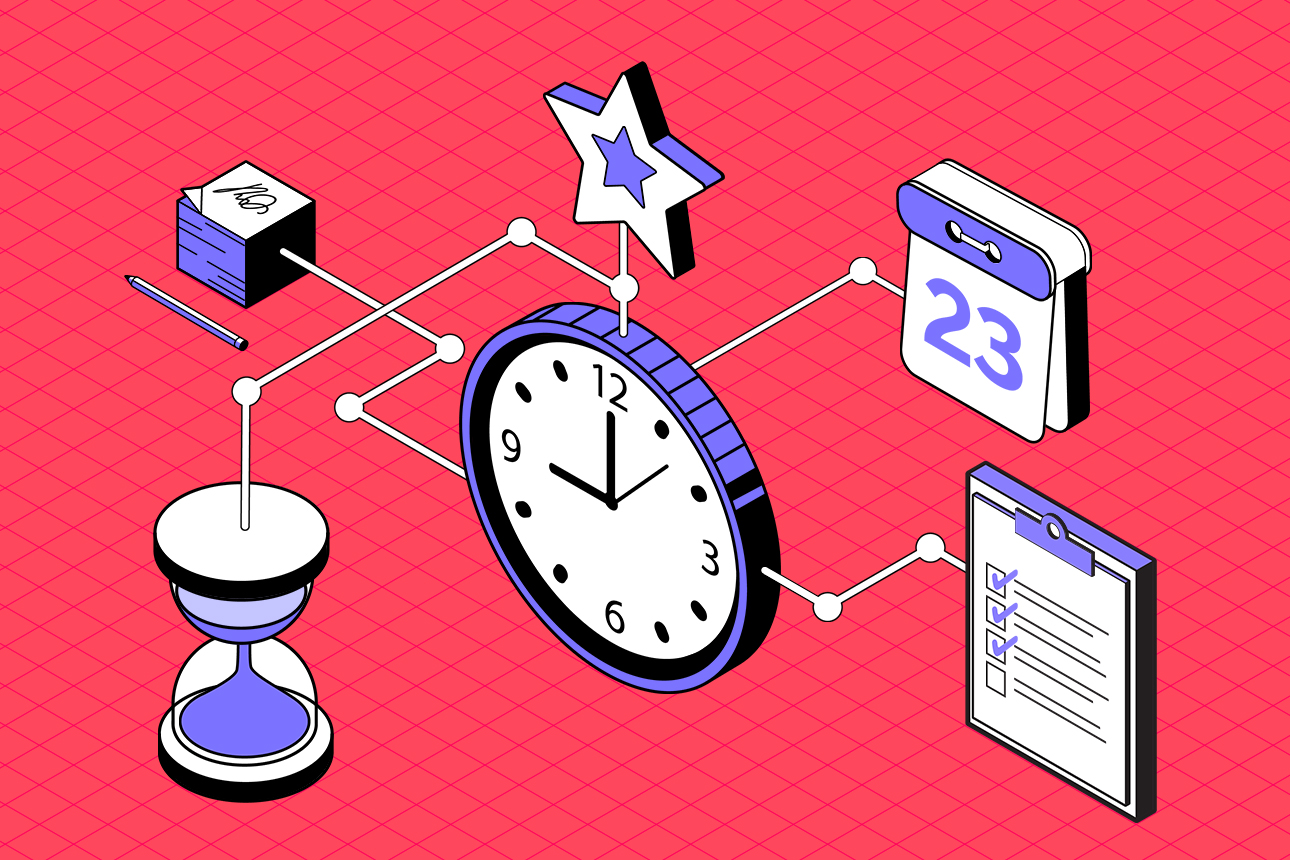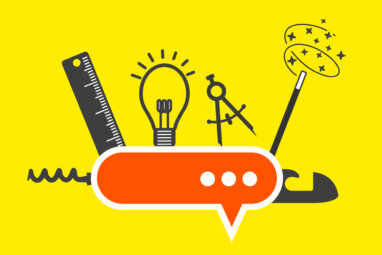How to Help Employees With ADHD Address the Challenges of Remote Work
Leaders can use these strategies to help workers stay focused and productive in virtual work settings, whether they’ve been diagnosed with ADHD or not.

Carolyn Geason-Beissel/MIT SMR | Getty Images
Editor’s note: In consultation with the authors, this article was updated June 26, 2023, to better reflect the views of the neurodiversity movement.
Flexible work arrangements, such as hybrid and remote models, have become important for talent acquisition and retention in the post-pandemic world. As organizations refine their virtual work practices, it is important to ensure that they are inclusive of neurodivergent employees. Attention-deficit/hyperactivity disorder (ADHD) is among the most prevalent neurodivergent conditions. While some individuals with ADHD may find that remote work is well suited to their needs and gives them a greater degree of control over their work environment, others may find that remote work presents unique challenges. Remote work often lacks concrete time cues and can introduce different kinds of distractions and methods for sharing information than an in-person office setting, which can be challenging for some people with ADHD. If these challenges are not managed effectively, they can lead to a host of issues, such as burnout, anxiety, productivity loss, demotivation, and, ultimately, quitting.1
Managers can work with employees with ADHD to implement simple strategies to better tailor remote work to their needs. Because employees may be undiagnosed or choose not to disclose their neurodivergent conditions, the five evidence-based interventions we suggest below can help foster better remote work practices to the benefit of all employees.2 But before we go into more detail about those, let’s briefly discuss ADHD.
Understanding ADHD
ADHD stems from structural differences in brain regions and variations in cellular and neural mechanisms that pose challenges to the daily self-regulation of goal-directed behaviors.3 Consequently, executive functions such as attention, time management, working memory, response inhibition, and mental processing of rewards operate differently to varying degrees in people with ADHD.4 These executive processes work together to help translate our bigger goals, visions, knowledge, and skills into daily goal-directed actions across all aspects of our lives, including work. Some individuals with ADHD may find that their differences disrupt these goal-oriented actions, even when they possess a clear vision, knowledge, skills, and motivation.5 Though medication can help regulate concentration, inhibition, and working memory, inclusive work practices and accommodations across five daily behavior dimensions can help to unlock potential and create the conditions for success.6
ADHD is often underdiagnosed in adults due to the misconception that it is only a childhood diagnosis or one that all children eventually grow out of.7 Gender and racial disparities in underdiagnosis introduce additional complications.8 Undiagnosed and untreated ADHD can lead to secondary anxiety and depression, as well as significant and sometimes devastating costs at both an individual and collective level in terms of lost productivity, health care expenses, unemployment, justice system impacts, and spillover costs to family members.9 A proper ADHD diagnosis and inclusive work practices can reduce these costs and enable individuals with ADHD to live fuller work and personal lives.
A proper ADHD diagnosis and inclusive work practices can enable individuals with ADHD to live fuller work and personal lives.
Gender differences in ADHD are frequently overlooked, which has widened the diagnosis and treatment gap for women.10 Males are three times more likely to receive an ADHD diagnosis than females, and they are typically diagnosed at a much younger age.11 Many early educators mistakenly believe that ADHD is mainly a diagnosis for boys and thus under-identify it in girls. Males generally present with hyperactivity and external displays of problems (such as classroom disruptions or fighting with peers), whereas females often internalize the symptoms of inattention, exhibiting low self-esteem, anxiety, and depression. This makes detection and referral more challenging among females, who may be misdiagnosed with anxiety or depression rather than ADHD. In the workplace, women with ADHD may feel overwhelmed and unsupported, and consequent low self-esteem and anxiety about deadlines or project details, or worries about making mistakes, can lead to decreased productivity, weakened performance, and missed career opportunities.
Implementing Inclusive Virtual Work Practices
The following inclusive virtual work practices use simple tools and feasible management strategies to create a work environment where employees can persist in doing what they already know how to do. Aligning virtual work practices around these suggestions can enhance the productivity of all employees. That said, neurodivergent employees often know what conditions are most conducive to their effectiveness at work and should be consulted on changes to work practices that affect them.
1. Time Management and Planning
While individuals with ADHD can effectively formulate a big goal or vision, some of them might struggle with daily minutiae, in large part due to time blindness, which is a skewed perception of time.12 This can lead to difficulty organizing activities in a timely manner to fulfill daily tasks and meet demands, along with procrastination, missed deadlines, forgotten and unfinished tasks, and difficulties with multitasking. Time management can be especially challenging in remote work models due to the lack of external time cues, such as driving to work or lunch breaks, and weaker daily supervision and accountability in these settings.
To support planning and time management, managers should work with their reports to translate big goals into daily, actionable chunks using an easily accessible daily planner. They can also create a daily accountability system, such as peer check-ins or daily progress charts. Using tangible markers of the passage of time, such as putting a clock on one’s home office desk, scheduling daily reminders to start a task, and setting timers to finish tasks, followed by breaks, can help as well. Whenever possible, managers should consider offering extended deadlines to factor in difficulties with time perception.
When working with virtual teams, managers should balance meeting schedules and productivity expectations.13 Think carefully about how many weekly team meetings are necessary and, when possible, use asynchronous communication to help employees perform the assigned tasks at their preferred time. Implementing a hybrid model in which people go to the office some days to attend meetings and remain home (or in a distraction-free office space) other days for focused work can be a viable option to balance productivity with meeting schedules.
2. Mental Organization and Working Memory
Due to differences in their working memory, some adults with ADHD may benefit from using external tools to do simple calculations, keep multiple pieces of information in mind while solving a problem, organize their thoughts while communicating, and remember to return calls or keep appointments. To support mental organization, encourage the use of external tools that bring important information into one’s visual field, such as daily checklists, Post-it notes, written instructions, color-coded visual cues, and clearly visible deadlines.
Remote work can be mentally taxing and feel overwhelming due to the speed and volume of information sharing. Having to attend multiple virtual meetings — which can incorporate a mix of video, audio, text chat, and file sharing — within a single day can be especially demanding, particularly for neurodivergent employees.
Rather than creating a competitive atmosphere where everyone vies for a chance to be heard, consider ways to make virtual meetings more accommodating and inclusive. For example, meeting organizers can formalize routines for taking turns and allowing people time to gather their thoughts before speaking; schedule pauses for questions and answers; and turn off chat features for large groups, to minimize distracting cross-talk. Sharing materials in advance and distributing notes, recordings, and transcripts afterward can also be especially helpful for those who find it difficult to take notes while simultaneously paying attention to conversations.
3. Self-Motivation on Prolonged Tasks
Certain individuals with ADHD might find it tough to stay motivated and focused during lengthy tasks without immediate rewards. Managers can encourage these employees to break down larger tasks into smaller steps, complete with mini deadlines and rewards. For instance, set 30-minute or one-hour goals and celebrate each accomplishment with small rewards, such as a cup of coffee or a short stroll outside. It’s important to set timers for these breaks to return to work; the Pomodoro Technique can serve as a helpful model.
To combat “Zoom fatigue,” allow for transition time in between back-to-back meetings, and provide breaks during longer meetings to regulate focus. This approach will help prevent employees from zoning out and can help them to recharge their mental energy.
4. Inhibition of Impulses
Individuals with ADHD can struggle with impulse control, causing them to react inappropriately, make impulsive comments, interrupt others, talk excessively, be emotionally reactive, experience difficulty waiting, or not recognize and fix mistakes quickly. These challenges can be even more prominent in remote settings, where social cues are limited.
Employing a coaching and feedback model can increase employees’ self-awareness about impulsive behaviors.14 Rapport-building practices, such as the use of a workstyle preference survey, can help managers discover ways to increase productivity and minimize frustration for neurodivergent employees.15 Remember to be compassionate and give employees grace; behaviors such as zoning out or speaking out of turn aren’t due to laziness or ill intentions but rather stem from differences in how information is processed.
The use of a workstyle preference survey can help managers discover ways to increase productivity and minimize frustration for neurodivergent employees.
Consider posting guidelines of best practices in a visible location to provide a clear framework for action. Similarly, incorporate productivity strategies like digital body doubling, in which employees can accomplish tasks that they find frustrating by working alongside others through virtual coworking apps (such as Flown or Focusmate) to help maintain focus on the tasks at hand.16 In addition, encouraging regular physical exercise and calming practices in daily routines is essential to help people replenish the mental resources required for self-control and inhibition of impulses.
5. Attention, Concentration, and Focus
Remote work is fraught with distractions and requires special considerations to enable increased focus. To enhance focus and minimize boredom, consider providing adjustable desks, knee chairs, wobble stools, and active seating. Schedule breaks to help people avoid zoning out, and, when they’re in the office, provide access to quiet spaces to minimize distractions. Consider offering assistive technology to help with task completion, such as dictation tools, audio recording software, and noise-canceling headphones, which can help all employees with productivity in remote and hybrid settings.
Our research has uncovered additional strategies that can help reduce distractions in virtual workspaces.17 Having meeting attendees use a uniform or blurred background can help minimize background noise and decrease visual triggers. Giving employees the option to turn off their cameras (for at least some part of the meeting) can be helpful to those who may become overly concerned about or distracted by their own facial expressions. Managers should also be mindful of the flurry of information that is available during online meetings and should be OK with employees asking for clarification in order to refocus after a moment of distraction.
ADHD can affect people’s ability to perform in many areas of their lives, including online work settings. Individuals with the diagnosis have different needs, ranging from not requiring any accommodations to needing reasonable personalized accommodations. The gender and racial differences in diagnosis, barriers to accessing care, and stigma have exacerbated ADHD’s costs to individuals’ overall well-being in the personal and professional domains. By adopting inclusive work practices, organizations can better support and tap into the talents of a diverse workforce that might otherwise be marginalized and underutilized.
References (17)
1. J.M. Szulc, F.-L. McGregor, and E. Cakir, “Neurodiversity and Remote Work in Times of Crisis: Lessons for HR,” Personnel Review (preprint, December 2021).
2. E.R. Russo, D.L. Ott, and M. Moeller, “Helping Neurodivergent Employees Succeed,” MIT Sloan Management Review, May 3, 2023, https://sloanreview.mit.edu; and R.A. Barkley and M.J. Poillion, “Attention-Deficit Hyperactivity Disorder: A Handbook for Diagnosis and Treatment,” Behavioral Disorders 19, no. 2 (February 1994): 150-152.








